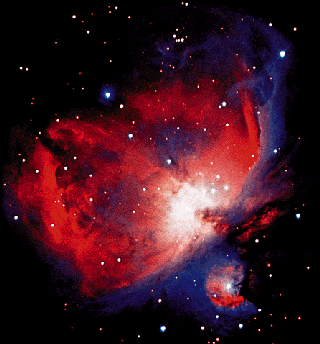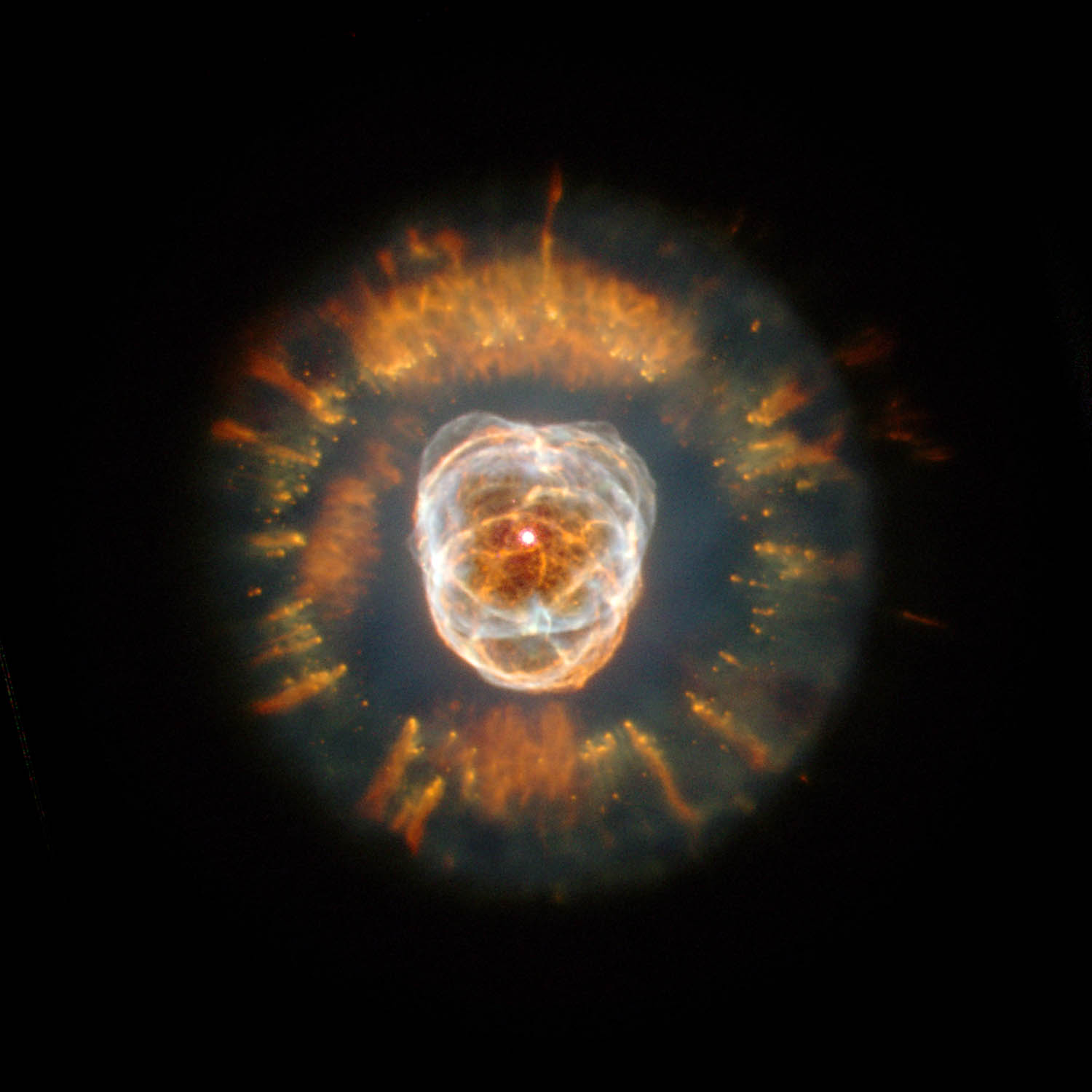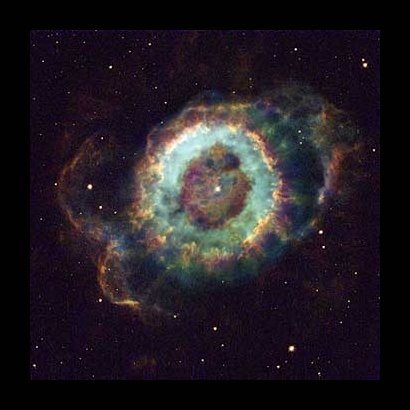Nebulae
 Originally, the word "nebula" referred to almost any extended astronomical object (other than planets and comets). The word "nebula" comes from the Greek word for "cloud." Before astronomers knew that galaxies were distant collections of stars, galaxies were also called nebulae because of their fuzzy appearance. Today, we reserve the word nebula for extended objects consisting mostly of gas and dust.
Originally, the word "nebula" referred to almost any extended astronomical object (other than planets and comets). The word "nebula" comes from the Greek word for "cloud." Before astronomers knew that galaxies were distant collections of stars, galaxies were also called nebulae because of their fuzzy appearance. Today, we reserve the word nebula for extended objects consisting mostly of gas and dust. Nebulae come in many shapes and sizes, and form in many ways. In some nebulae, stars form out of large clouds of gas and dust; once some stars have formed inside the cloud, their light illuminates the cloud, making it visible to us. These star formation regions are sites of emission and reflection nebulae, like the famous Orion Nebula shown in the picture on the right.
Emission nebulae are clouds of high temperature gas. The atoms in the cloud are energized by ultraviolet light from a nearby star and emit radiation as they fall back into lower energy states (neon lights glow in much the same way). Emission nebulae are usually red, because hydrogen, the most common gas in the universe, most commonly emits red light. Reflection nebulae are clouds of dust that simply reflect the light of a nearby star or stars. Reflection nebulae are usually blue, because blue light scatters more easily. Emission and reflection nebulae are often seen together and are sometimes both referred to as diffuse nebulae. In some nebulae, the star formation regions are so dense and thick that light cannot get through. Not surprisingly, these are called dark nebulae.
Another type of nebula, called a planetary nebula, results from the death of a star. When a star has burned through so much material that it can no longer sustain its own fusion reactions, the star's gravity causes it to collapse. As the star collapses, its interior heats up. The heating of the interior produces a stellar wind that lasts for a few thousand years and blows away the outer layers of the star. When the outer layers have blown away, the remaining core remnant heats the gases, which are now far from the star, and causes them to glow. The resulting "planetary nebulae" (so named because they look like gas giant planets through a telescope) are shells of glowing gas that surround a small core. Astronomers estimate that our galaxy contains about 10,000 planetary nebulae. Planetary nebulae are a common part of the normal stellar life cycle, but they are short-lived, lasting only about 25,000 years.
 The life of a star whose mass is greater than 1.4 times the mass of the Sun ends more violently, and leaves behind a different type of nebula called a supernova remnant. When such a star runs out of fuel and collapses, an enormous shock wave sweeps through the star at high speed, blasting away various layers and leaving behind a core called a neutron star and an expanding shell of matter known as a supernova remnant. A supernova's shock wave is much more violent than the stellar wind that marks the end of a low mass star. Near the core of the remnant, electrons emit radiation called "synchrotron radiation" as they spiral toward the neutron star at speeds close to the speed of light. The ultraviolet portion of this radiation can strip electrons off, or "ionize" the outer filaments of the nebula, causing them to glow. In addition, the ejected matter sweeps up surrounding gas and dust as it expands, producing a shock wave that excites and ionizes the gas in the supernova remnant nebula, which is at low density but extremely hot (up to 1,000,000° K!). The most famous supernova remnant is the Crab Nebula in Taurus (M1), shown in the image above. The light of the inner core is from synchrotron radiation, while the outer regions glow in many colors from emission of many gases, including red for hydrogen.
The life of a star whose mass is greater than 1.4 times the mass of the Sun ends more violently, and leaves behind a different type of nebula called a supernova remnant. When such a star runs out of fuel and collapses, an enormous shock wave sweeps through the star at high speed, blasting away various layers and leaving behind a core called a neutron star and an expanding shell of matter known as a supernova remnant. A supernova's shock wave is much more violent than the stellar wind that marks the end of a low mass star. Near the core of the remnant, electrons emit radiation called "synchrotron radiation" as they spiral toward the neutron star at speeds close to the speed of light. The ultraviolet portion of this radiation can strip electrons off, or "ionize" the outer filaments of the nebula, causing them to glow. In addition, the ejected matter sweeps up surrounding gas and dust as it expands, producing a shock wave that excites and ionizes the gas in the supernova remnant nebula, which is at low density but extremely hot (up to 1,000,000° K!). The most famous supernova remnant is the Crab Nebula in Taurus (M1), shown in the image above. The light of the inner core is from synchrotron radiation, while the outer regions glow in many colors from emission of many gases, including red for hydrogen.SOME WORLD FAMOUS NEBULAS::::
HORSE HEAD NEBULAE
TRIANGULUM NEBULAE
ORION NEBULA
HST ESCIMO NEBULAE
NEBULAE - OF -BEAUTY
LITTLE GHOST NEBULAE
AND MANY MORE..............................







No comments:
Post a Comment